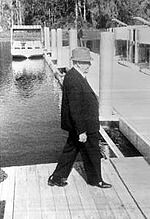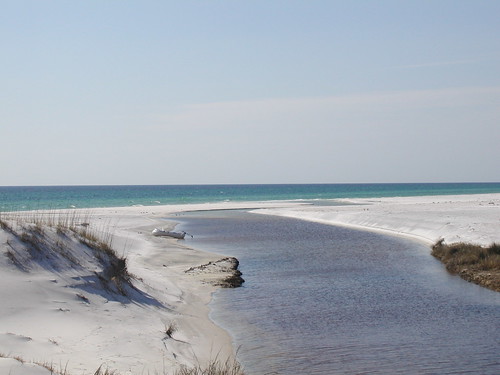In 1959 Walt Disney began looking for land for a park to supplement Disneyland, which had opened in Anaheim, California in 1955. Disney’s vision had outgrown the existing park, and he did not like the businesses that had sprung up on adjacent properties.
Company research found that only 2% of Disneyland guests came from east of the Mississippi – where 75% of the U.S. population lived – so the search for an east coast site was on.
According to legend, Disney originally wanted to build his new park near the beach, a natural magnet for tourists. Disney’s search for a large tract of undeveloped beachfront led him to the Florida Panhandle.
In 1959, if you wanted to buy land near Northwest Florida’s white sand beaches, there was only one man to see: Ed Ball, CEO of The St. Joe Paper Company.
 Ball was the brother-in-law of Alfred I. DuPont, the black sheep of the DuPont family, who had been banished to Florida after divorcing his first wife and marrying his second cousin.
Ball was the brother-in-law of Alfred I. DuPont, the black sheep of the DuPont family, who had been banished to Florida after divorcing his first wife and marrying his second cousin.
Ball was a notoriously tough businessman, and he would end each day with a whiskey and a toast: “Confusion to the enemy!”
When DuPont died in 1935, Ball took control of the family business and spent the next 45 years acquiring land in Florida. Eventually Ball controlled more than a million acres, most of it concentrated in the Florida Panhandle.
As the story goes, Disney had his sights set on a Florida beachfront location for his new park, so he dispatched lawyers, lobbyists and friends to negotiate a land purchase from Ball, but Ball rebuffed every approach.
Finally in March 1959, in a last ditch effort, Disney made an appointment to meet Ball at his office. He was determined to buy a piece of beachfront property near Panama City Beach, Florida.
Disney arrived at the St. Joe Paper Company offices promptly at 9 am. The office was quiet as a tomb; the only sound was the tick-tock of a grandfather clock in the corner of the reception area. Down the hall he could see the door to every office was closed.
Irene Walsh, Mr. Ball’s secretary, took Disney’s coat and asked him to have a seat. Mr. Ball was busy, she said, and he would see Disney when he could.
As the day passed, every hour, on the hour, Ms. Walsh would take printout from the company’s stock ticker to Mr. Ball’s office. And each time she returned she brought Disney the same message: “He’s still busy.”
At noon, Ms. Walsh told Disney: “Mr. Ball asked me to go out and get you lunch.”
The afternoon passed in utter quiet, broken only by the tick-tock of the clock and Ms. Walsh’s hourly treks to Ball’s office.
Finally, at 4 pm, after she had taken the day’s closing stock prices to Mr. Ball’s office, Ms. Walsh returned with a note for Disney. The crumpled piece of paper had been folded eight times.
Disney opened the note: “Mr. Disney, I’m not going to see you today – or any day. I don’t do business with carnival people.”
Disney gave up on the idea of a beachfront resort and began secretly accumulating 30,000 acres outside Orlando, Florida, bordering the area where Interstate 4 was going to be built.
The rest, as they say, is history.

